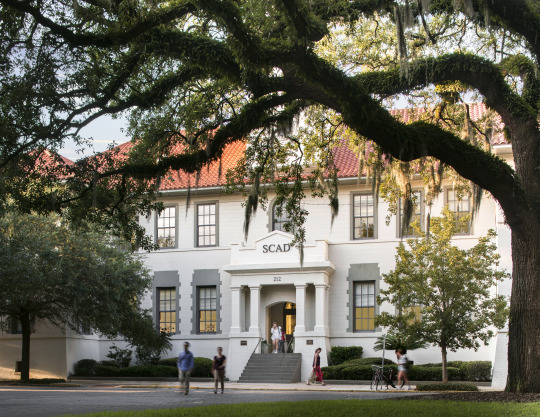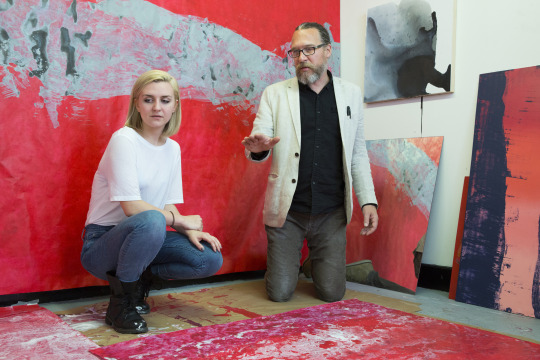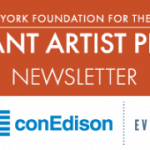#NYFAPartner Spotlight | Swipe Right: How to Fall in Love with the Perfect Grad School
Paula Wallace, President and founder of the Savannah College of Art and Design (SCAD), kicks off our “Get Into Grad School” series.
New York Foundation for the Arts (NYFA) is pleased to launch a new series for artists and arts professionals who are considering graduate school as the next potential step in their careers. We’ve invited Paula Wallace, President and founder of the Savannah College of Art and Design (SCAD), to launch a new “Get Into Grad School” series on our blog, NYFA Current. In the guest essay presented here, Wallace contends that a master’s degree can positively impact an individual’s income for years after graduation, and that for some, a Master of Fine Arts degree, or M.F.A., is a necessity. Read on for Wallace’s take on the graduate school application process, which she likens to dating.
Matchmaking Essentials from Paula Wallace
According to the Council of Graduate Schools, about half a million students will enter a serious committed relationship with their chosen graduate school this year. Why? Because a graduate degree virtually guarantees between 19 and 44 percent more weekly income than those who end their educations at the undergraduate level. According to a recent economic impact study at SCAD, where I serve as President, a master’s degree increases average earnings by $13,500 every year. The benefits of graduate study are many, especially for artists and designers seeking to advance their careers and enrich their lives with the ultimate creative credential: the mighty Master of Fine Arts degree.

The M.F.A., as opposed to the M.A. or a certificate, is absolutely essential if you want to teach full-time in higher education. Just as a licensed attorney requires a Juris Doctor (J.D.) degree, so a professor in a creative degree program must hold an M.F.A. from an accredited university to be credentialed to teach. What’s more, if you want to work in the private sector as a furniture designer, copywriter, photographer, stylist, independent artist, magazine editor, etc.—the job possibilities are endless—then the M.F.A. testifies to your advanced career preparation and deep historic knowledge of the profession. In short, this degree is the gold standard for creative careers and, as such, represents a serious commitment of time and resources. So, how do you find the right program for you?
1. Decide what you want in a relationship.
Grad schools are like peonies: Look at a bouquet from a distance, and they all seem alike. But get a little closer and you see how different each one is. Your choice of program will, in many ways, determine the trajectory of your career. What are your professional goals? Want to work for Pixar or Dreamworks Animation? Then look for universities where these companies recruit. Find a program whose professors have worked where you want to work! Read faculty bios and the course catalog to learn who’s teaching. A little online research goes a long way.

2. Find a place that makes you swoon.
Never underestimate the value of visiting campus. You’re going to spend two or more years of your life on a campus, deeply engaged in serious studio work— making, writing, designing—and the built environment matters. Thomas Jefferson believed what all great educators know by instinct, that a university’s “taste, values, and ideals” are embedded in the architecture. Once you’ve swiped right on a few promising grad schools, it’s time to meet IRL and see those values for yourself. For example, at SCAD, you’ll find the built environment actually mirrors and models the very disciplines we teach. Our university environment is a glorious mélange of historic architecture, contemporary design, digital technology, and visual art. When you visit SCAD, it’s clear what we love (hint: everything that’s beautiful and useful). Visit your top grad school choices. What’s the most striking architectural feature you notice? If it’s the football stadium, you might reconsider your choice.

3. Look a decade down the road.
Think about the future, and find out if the university’s graduates actually find professional work. Call up the offices of graduate studies and ask if they publish employment information for recent alumni. We do, and others do, too. Compare employment rates. Reach out to the department chair and ask where their graduates are working. If you’re interested in an M.F.A. in advertising and want to be a copywriter, ask for the names of young alumni who are doing just that. The top programs will respond with positivity and enthusiasm, providing names and email addresses. Call up these alumni and ask how they found their job. Was it a professor contact? An alumni contact? A career fair introduction? A campus recruiting event? Pro-tip: Find a university that provides ongoing career opportunities for graduates, like this alumni residency or this alumni product launch platform. You don’t want to be forgotten by your alma mater once you complete your degree program.
4. Compose a love letter.
By now, you’re probably in love. Time to make it known with an application and a portfolio. The portfolio is key, demonstrating to faculty members that you possess a gift for invention and strong technique, and that you’re ready for a serious professional studio experience. Of course, I advise that applicants always follow portfolio guidelines, while adding value to your application by applying what you learned in the first three steps described above. Use common sense. Are you seeking an M.F.A. in nonfiction, in which you can work with great magazine journalists? If so, don’t fill your portfolio with fiction. Does the university value tradition or does it privilege innovation and technical diversity? Let the answer guide your portfolio choices.
And don’t forget to declare your love in writing. These days, every artist and designer must also be comfortable with words: You’ll have to write pitches, briefs, bios, artist statements, and copy for your own website. Draft an application letter that tells your love story, describing your search for the perfect program—and why you believe they’re the one. Faculty members will be impressed by your thoroughness. A great letter that tells a compelling story will make your portfolio shine even brighter. Spring is in the air, friends, and so is love. Get out there and find the grad school that you’ve been dreaming about!

– Guest Essay by Paula Wallace, President and founder of the Savannah College of Art and Design (SCAD)
This post is part of a regular blog series highlighting sponsor organizations, and the first in the “Get Into Grad School” series on NYFA Current. Follow NYFA on Twitter, Facebook, and Instagram to see the latest news about each #NYFAPartner. Sign up for NYFA’s bi-weekly newsletter, NYFA News, to receive announcements about future NYFA events and programs.
Images: courtesy of Savannah College of Art and Design (SCAD)





